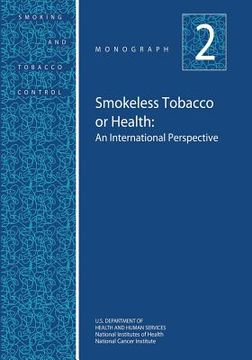Smokeless Tobacco or Health: An International Perspective: Smoking and Tobacco Control Monograph No. 2 (en Inglés)
Reseña del libro "Smokeless Tobacco or Health: An International Perspective: Smoking and Tobacco Control Monograph No. 2 (en Inglés)"
Large-scale consumption of tobacco has been a significant lifestyle factor in America for centuries . Prior to the beginning of the 20th century, tobacco was consumed in the form of spitting tobacco (chewing tobacco and snuff), smoked as cigars, or loose tobacco smoked in pipes or in hand-rolled cigarettes. Consumption of machine-made cigarettes was almost nonexistent, and spitting tobacco was the dominate form of use, accounting for nearly 60 percent of all tobacco consumed on a per capita basis. Consumption of machine-manufactured cigarettes increased dramatically following World War I; by 1935, more tobacco was being consumed in the form of cigarettes than all other products combined. As the popularity of cigarettes continued to increase, consumption of noncigarette tobacco products, especially smokeless tobacco, declined. Per capita cigarette tobacco consumption peaked in the early 1950's (as did total per capita tobacco consumption), probably in response both to the first scientific studies linking cigarette smoking to lung cancer and to the introduction and aggressive promotion of filter cigarettes by the cigarette industry in response to these early scientific findings. Filter cigarettes, which had previously accounted for less than 1 percent of all cigarettes consumed in the United States in 1950, had captured 50 percent of the market by the end of the decade, and today account for over 90 percent of all cigarette sales. In comparison to their nonfilter counterparts, filter cigarettes generally contain less tobacco. For decades following the introduction of the mass-produced and mass marketed cigarettes, consumption and prevalence of smokeless tobacco had been on the decline. However, the latter part of the 1970's and the early part of the 1980's, saw major increases in ST use. This increase was the result of renewed and more aggressive advertising by the ST industry that accompanied the introduction of innovative products such as Skoal Bandits-and the use of well-known sport and entertainment personalities in ST promotions . Personalities such as football stars Walt Garrison and Terry Bradshaw; baseball greats George Brett, Sparky Lyle, Carlton Fisk, and Bobby Murcer; and country-and-western singer Charlie Daniels, obviously appealed to a very young and impressionable audience. Furthermore, use of broadcast media to promote ST was not prohibited under the existing Congressional legislation that had governed cigarettes since 1971; thus, the ST industry was free to use television to recruit a large and relatively untapped market of new users. Because the themes and images used appealed primarily to children and adolescents, increases in ST consumption that occurred during the 1980's was primarily confined to these age groups . Where previously little or no use of ST was seen among adolescents, prevalence of ST use among older teens increased between 250 and 300 percent between 1970 and 1985. Compared with cigarettes, we know much less about the factors influencing ST use. Only in the past few years have the research results elucidated the many facets of ST use and means to intervene in this process. This monograph represents the most recent major attempt to bring together the important research findings of the last few years. Previous compilations of ST research have been the U.S. Surgeon General's Report in 1986 and a monograph published by the National Cancer Institute in 1989, titled Smokeless Tobacco Use in the United States. The present monograph will use the model established by the two previous publications in presenting as broad a picture of the ST problem as possible. Sections in this monograph describe the epidemiology, clinical and pathological effects, carcinogenesis, nicotine effects and addiction, prevention, cessation, and policy research findings in the area of ST use. Finally, recommendations based on research and compiled by experts in the field is presented.

